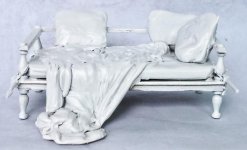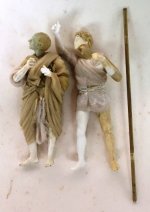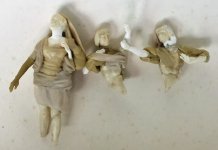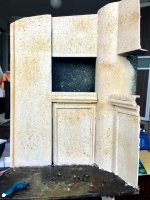Introduction
Once in a while, you come across a striking incidental scene of a group of people which just cries out to be transformed into a 3-dimensional vignette. I refer to this painting 'Antony brought dying to Cleopatra' by the French painter Eugène Ernest Hillemacher (1818-1887)[SUP]1[/SUP]. The painting was executed in 1863 and currently resides in the Musée de Grenoble (Fig 1).
‘From atop the monument with her maids, Charmian and Iras, Cleopatra declares that she will never leave her hiding place. Antony’s guard has brought him to Cleopatra where Antony says that he is dying and wishes to embrace her one last time. She replies that she dares not come down from her monument, lest she be captured by Caesar and paraded through the streets as a prisoner. Instead, Cleopatra asks the soldiers and servants to heave Antony up to her for one last embrace.’
(short summary of Act IV, Scene xv (Shakespeare).
Mark Antony and Cleopatra VII were the famous tragic lovers of the Roman Empire. ‘Antony and Cleopatra’ is a
tragedy by
William Shakespeare and first performed in 1607[SUP]2[/SUP]. The painting closely follows William Shakespeare’s plot. Antony was losing the final land battle when, upon hearing of the false news that Cleopatra was dead, fell on his own sword, mortally wounding himself. The dying Antony was then brought back to Egypt to die in the arms of Cleopatra.
‘Cleopatra: Here's sport indeed! How heavy weighs my lord!
Our strength is all gone into heaviness,
That makes the weight: had I great Juno's power,
The strong-wing'd Mercury should fetch thee up,
And set thee by Jove's side. Yet come a little,—
Wishes were ever fools,—O, come, come, come;’
The words of Cleopatra above suggest that it was quite an effort to lift Antony up. The painting shows his shrouded body being carefully hoisted up by soldiers and servants with tied sheets and ropes to greet the grief-strickened Cleopatra. This painting is really about the apotheosis of Antony, the exaltation of Antony to mythical sainthood. The scene suggests a beatific transfiguration occurring as Antony is gradually lifted up, with his arms wide open to receive divine grace.
What great drama that has been perfectly captured in this genre painting! The costumes and settings are not necessarily accurate but they embody the ‘Neo-classical/orientalism’ style of painting. Elements of the painting, such as the statue of the Egyptian lion goddess Sekhmet[SUP]3[/SUP], the hieroglyphics on the monument walls, the quasi-Roman helmet, toga and the Roman standard firmly places this as a Roman tragedy playing out on Egyptian soil.
I especially liked the composition of the painting – the placement of the supporting figures at varying heights directing the viewer’s gaze downwards from the left side into the painting, and then redirecting it upwards through the upward faces and hand gestures of the two figures on the right side towards the grieving group of women on the parapet. The taut rope lines further redirects the gaze downwards towards Antony. The pristine white cloth sheets, with a single splash of blood, draped on the bed and falling to the foreground suggest life essence oozing out from the dying Antony.
Closer examination of the painting shows that there are two spears tied to each end of the settee, acting as handles to use the settee as a litter for the wounded Antony. There is another spear, a cloth bundle and more coils of rope in the foreground.

Fig 1. “Antony brought dying to Cleopatra” painting.







































